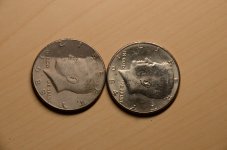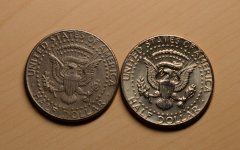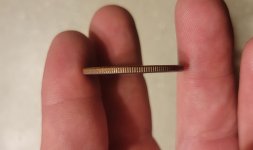Fugio
Sr. Member
- Feb 25, 2016
- 266
- 486
- Detector(s) used
- Legend, AT Pro, Garret Pro-Pointer AT
- Primary Interest:
- All Treasure Hunting
So I just got through with a box of half dollars and got skunked. The only exception was this interesting coin. It appears to be some sort of planchet error, but one I have not come across before. There is a line cutting through Kennedy's nose, as well as the date. All details are soft on obverse and reverse. Surfaces are mottled and dark, absolutely no luster or wear to surfaces. Thoughts? Error coin is on the left in attached images along with an average Kennedy of similar vintage, but normal appearance.







